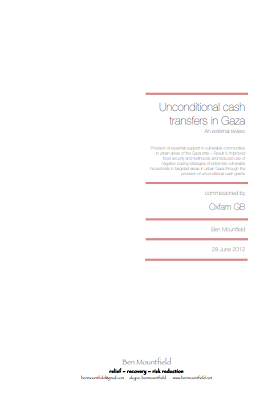Unconditional cash transfers in Gaza: an external review
This is a review of small pilot project, which targets extremely vulnerable households with monthly unconditional cash transfers for a limited period. The target population is made up of two groups, one group already receiving assistance through a voucher from WFP but still showing poor food diversity scores, the other initially receiving no other assistance and referred by the Ministry of Social Affairs (MoSA). All beneficiaries received a flat rate monthly amount of 260 NIS – about €50, paid through the banking system.
The Ma’an Development centre managed the project implementation as a partner of Oxfam GB. Project monitoring is comprehensive, and the resultant dataset provides a good basis for the determination of impact. This has been triangulated through interviews with key informants and focus groups with beneficiaries and staff.
However, some revisions to monitoring tools and processes are necessary for the next round of the project, specifically relating to the measurement of expenditure and the better understanding of people’s coping strategies and responses to blockade and the resulting food security.
The project is found to be appropriate and to have positive, quantifiable impact in terms of food consumption and dietary diversity; a quantifiable reduction in levels of short-term household debt and the use of negative coping strategies, and a reported but unquantifiable impact in reducing levels of domestic violence. This is true for both groups.
The modality of an unconditional cash distribution is acknowledge to be more expensive than an in-kind distribution of food, but the added benefits reported include increased dignity, choice and the ability to address a wider range of needs that can be addressed through the provision of staples. The intervention is complementary to the sub-group that receive it.
The impact of the project on gender dynamics in the household is seen as positive, and the choice of a cash modality appears to be a contributing factor. This needs to be understood in the context of the swiftly changing roles of men and women as a result of the blockade: where women have largely taken over responsibility for accessing resources to feed their household, yet those resources are in too short supply. The psychological impact of this blockade on men, especially associated with the loss of the role of breadwinner, might be explored in more depth.
All indicators reviewed showed strong improvement over the baseline situation that can be attributed to the project. However, the proxy food security indicators have not improved to the point where household food security of beneficiaries can be described as good.
The review found that the cash transfer is typically spent within 2-3 weeks of being received, leaving a shortfall towards the end of the month. It is found to be adequate for a household of 4 for a month, while the average household size within the project is around 7.6.
The expenditure period is strongly (and inversely) correlated with the size of the household. The review therefore recommends that the amount of the cash transfer should be increased and scaled to the household size, to ensure that it is sufficient for the targeted household and that the impact is maintained throughout the month.
Further, since the project is of limited duration, the benefits will cease when the project will cease. For a sub-group of the MoSA beneficiaries, this will be offset, at least in part, by their recent inclusion in a MoSA protection scheme, which is longer term. For most it presumable means a rapid return to their baseline situation. This effect could be quantified through a final proposed round of monitoring two months after the last payment.
Detailed analysis of how cash transfer is spent is complicated by the fact that it represents – in many cases at least – only a proportion of the total household income. Recording the expenditure of the cash transfer in isolation invites a degree of selection on the part of the beneficiary as to what is reported under the transfer, and which expenditure are allocated elsewhere.
There are limited multiplier effects associated with these cash transfers. They are too small and too effectively targeted at those households that struggle to meet their daily needs: they provide little scope for promoting production or value addition.
The review finds that too little is known about the processes by which families support each other, the network through which they do so, and the health of those networks. Much is written about the resilience of the Gaza population, but tools to measure that resilience are hard to find. A model to understand and explore these networks is proposed, together with some potential proxy indicators – some of which are already collected through the SEFsec process. There is evidence that the resource base is being hollowed out : for example, some asset sales were identified during the implementation period amongst project beneficiaries, despite the fact the weakness of that particular monitoring tool would lead to under-reporting.
As part of this understanding, future monitoring of impact should include a consideration of the total number of family members living in one residence, who share food frequently, as well as the standard measure of household size, typically used to determine the level of inputs.
The widespread use of the Proxy means of Targeting Formula by the UN and the MoSA has been the subject of debate, and this review highlights some concerns relating to its use and effectiveness.



